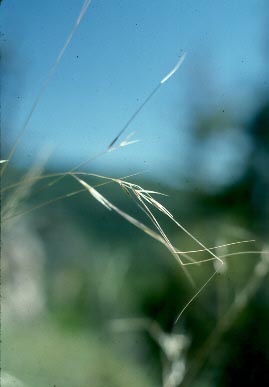Needle-And-Thread

Common Name(s):
Needle-and-Thread
Scientific Name:
Hesperostipa comata (Trin. & Rupr.) Barkworth
Scientific Name Synonyms:
Stipa comata
Symbol:
HECO26
Description:
Life Span: Perennial
Origin: Native
Season: Cool
Growth Characteristics: An erect to ascending bunchgrass without rhizomes, growing in small tufts usually not exceeding 4 inches in basal diameter; seedstalks 1 to 3 feet tall. Starts growth in early spring or when moisture is available. Seeds mature in early summer. Reproduces from seeds and tillers.
Seedhead: Loosely spreading panicle, 4 to 8 inches long; lowermost spikelets enclosed or partly enclosed in the uppermost leaf sheath; one floret per spikelet; glumes ¾ to 1 inch long; papery, and remain attached to plant when seeds fall; hard seed coat formed by lemma and palea; awn on lemma is twisted, wavy, 4 to 5 inches long and hygroscopic (winds up and unwinds as it becomes wet or dry as a means of natural seeding). The seed has a sharp attachment point (callus) with beards near the point.
Leaves: Glabrous and prominently veined; blades narrow, usually enrolled, 3 to 12 inches long, rough above, tapering to a point; stem leaves shorter and wider; ligules conspicuous, 1/8 inch long and notched; auricles absent.
Ecological Adaptions:
Needle-and-thread is a native of Utah, as well as being native to much of the West and the Great Plains. In Utah, it is found at elevations between 4000 and 7500 feet on alluvial fans, sandy benches, and gravelly foothills. It occurs in the 10 to 18 inch rainfall belt.
Needle-and-thread comprises up to 25 percent of the total vegetation on some mountain sites and also grows on certain upland and semi-desert sites. It is widely distributed throughout Utah and is very tolerant to drought with good management.
Soils: Well adapted to excessively drained, sandy or gravelly soils and also to shallow or deep sandy loam, fine sandy loam, or even clays that are shallow to deep, with widely varying amounts of stones and rock fragments.
Associated Species: Associated species are sandberg bluegrass, Junegrass, Indian ricegrass, and big sagebrush.
Uses and Management:
Needle-and-thread grass is good forage during the spring before seeds develop and again during the fall after seeds have dropped, especially after fall rains. It is choice feed for deer during the spring, and elk in the winter, providing a good source of energy. It cures well to provide fall and winter forage for livestock. If grazed when seeds are ripe and still on the plant, the sharp pointed callus and long awns may cause injury by working into the eyes, tongue, and ears. Sheep are especially susceptible to injury; awns may contaminate the fleece and carcass. It can cause severe damage by penetrating the hide into the flesh.
Watershed value and soil conservation values make it a very desirable plant especially on wind-eroded soils (sandy areas). Depleted stands can be restored through proper grazing. It will maintain its vigor and productivity with 50 percent use of the total annual yield, where continuous grazing is practiced.

